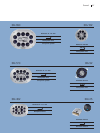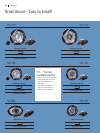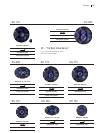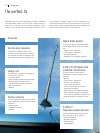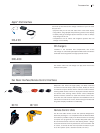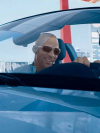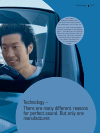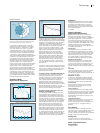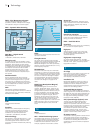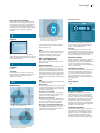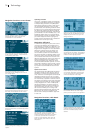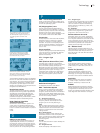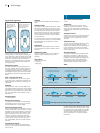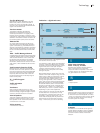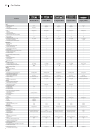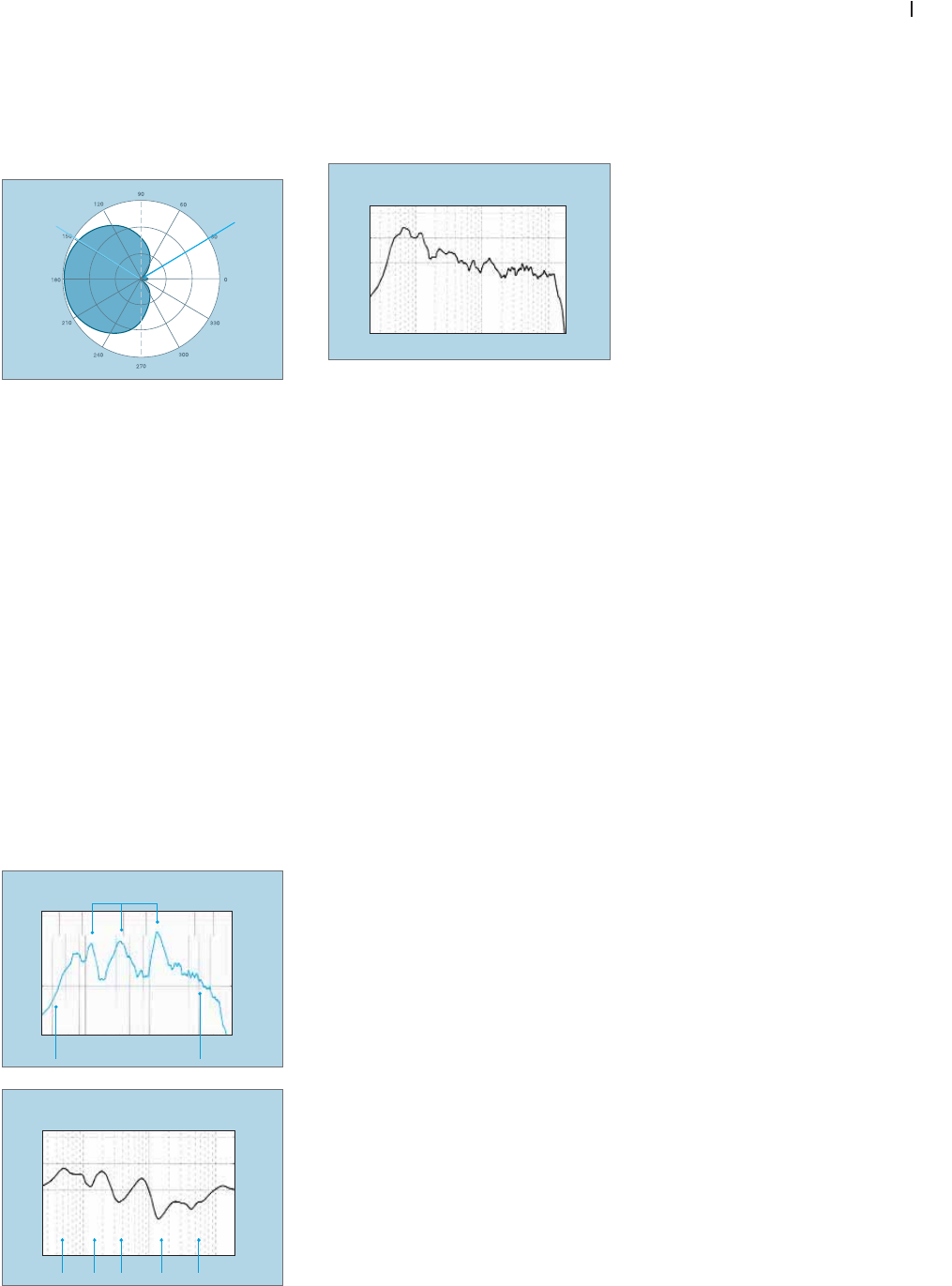
Vehicle-specific frequency response without DSA
+
correction
Amplitude
in dB
20
10
0
–10
–20
–30
10
2
10
3
10
4
Frequency
in Hz
Annoying frequency
response peaks
Lack of
deep bass sound
Lack of
brilliant trebles
125
350
1400
Correction using DSA
+
(13 EQ bands)
Amplitude
in dB
20
10
0
–10
–20
–30
10
2
10
3
10
4
Frequency
in Hz
Filter 1 Filter 2 Filter 3
Filter 4
Filter 5
Vehicle-specific frequency response with DSA
+
correction
Amplitude
in dB
20
10
0
–10
–20
–30
10
2
10
3
10
4
Frequency
in Hz
75
Technology
DigiCeiver
Technology, whereby the car radio is based
on signal/computer processors. The signal
is digitally processed from the receiver to
the Preamp Out. This affords considerable
advantages in terms of reception properties
and sound adaptation.
➞ SHARX®
Digital radio/DAB –
Digital Audio Broadcasting
Digital radio standard that, in contrast to
analogue radio signals, makes it possible
to transmit a great deal of data. In addition to
audio signals and texts, it is also possible
to transmit programme information in the
form of images and HTML pages. Even moving
images are possible. With digital radio, many
familiar programmes are now available in
CD quality, along with an entire spectrum of
completely new stations.
Interference
Should there ever be any problem in the
transmission of a digital signal, it is usually
only a small part of the information that gets
lost. And the listener won’t even notice: the
digital correction process simply recreates
the original signals. This guarantees inter-
ference-free listening enjoyment every time.
Reception convenience
Digital radio programmes are transmitted
over just one frequency. This means that,
once you have tuned into a programme, you
will be able to listen to it anywhere within
reception range without having to adjust your
set.
Versatility
Even though digital radio is bound to replace
FM as the radio standard sooner or later,
the Blaupunkt digital radios all still include an
FM receiver as well.
Additional reception
In the future, digital radio will also be able
to receive such additional multimedia infor-
mation as telematics services, information on
song titles, weather reports and MP3 files.
Sound quality
Digital radio provides the same excellent
sound quality as a music CD, even at top
speed on the motorway.
Future standard
It is already possible to pick up digital radio
almost everywhere in Germany. Full coverage
is expected to be achieved by 2004. And since
digital radio is a European standard, it will
be available in all European countries in the
future as well.
Programme diversity
Digital radio doesn’t mean you have to make
do with fewer programmes. In Germany,
there are already more than 150 digital radio
programmes on air – and that number is
growing.
Disc-Naming
This function makes it possible to enter a
name for any CD currently playing. This name
will then appear in the display each time
the CD is played as long as the corresponding
display function has been activated.
Display-Out
Connection option for existing external
displays in the car via an optional interface.
DMB – Digital Multimedia
Broadcasting
➞ Digital-Radio
Equalizers that do the thinking for you! The
intelligent Blaupunkt equalizers are equipped
with a self-adjusting function to automatically
optimise sound reproduction. The new DSA
+
equalizer is a complete high-performance
24-bit DSP system. The computer has enough
power to handle the 4-channel self-adjust-
ment of 27 graphic equalizer bands (= 108
bands in total). This creates a sound quality
that remains unparalleled to date and can
also be adjusted to your personal taste.
Signal time alignment for the audio signal
guarantees a true-to-life, concert-like pano-
rama. Dynamic Noise Covering (DNC) auto-
matically adjusts the volume, the equalizer
and music dynamics to the current noise
background in the vehicle. And this feature
not only regulates the level, it also adjusts
the sound to the frequency spectrum of the
driving noise.
A spectrum analyser, fascinating effect sound
options for Club, Stadium, Cathedral, Theatre
and Concert as well as sound presets round
out the virtually unlimited opportunities to
individualize your sound!
Parametric bands in DEQ Max/DEQ Max EX:
For particularly easy operation and the out-
standing adjustment of the complicated
acoustic conditions in modern vehicles, the
DEQ Max EX equalizer uses five fully para-
metric bands (adjustable mid frequency,
quality and level) with an automatic self-
adjusting function (in systems with the DEQ
Max, the parametric 5-band equalizer requires
manual adjustment). In addition, you can
also choose individually from five pre-defined
sound curves for different music styles.
Automatic equalizer adjustment with the
DSA Max and DEQ Max EX:
To keep things simple and ensure that the
best possible sound is what you get in the
end, Blaupunkt has developed an automatic
self-adjusting function that measures the pro-
blematic frequency response individually in
every vehicle. All you have to do is to connect
the calibration microphone (comes included
with the Bremen MP74 and the Los Angeles
MP74) with the ISO connection box and
press the AUTO key in the equalizer menu.
After just a few seconds, the sound will be
noticeably more harmonious, richer in detail
with greater differentiation, as the annoying
frequency peaks are reliably balanced out.
To satisfy personal tastes, all the settings can
also be adjusted manually afterwards. Alter-
natively, the sound-related or voice-optimised
sound preset curves can also be selected.
In principle, the DDA process mimics the
reactions of an extremely quick, automatic
directional antenna – similar to TV “rabbit
ears” that deliver just “snow” or perfect
reception depending on just a small adjust-
ment. When used in car radios, the DDA pro-
cess works with two independent antennas
and receivers, whose signals are digitised
using intermediate frequency analogue-digital
converters. The digitised data is then fed
to an adaptive algorithm with extremely low
settling times. Thus, the two intermediate
frequency signals are combined so that the
antenna can gain up to 3 dB of antenna
power even for weak reception field strengths.
In areas with strong reception, the second
regular receiver, the so-called RDS back-
ground receiver, is then freely available. The
switch between DDA operation and RDS
background reception is quick and inaudible,
controlled by a logic that evaluates the cur-
rent reception conditions. This guarantees
the radio listeners the best possible recepti-
on and rapid frequency switching at all times,
without annoying station searches.
DEQ/DEQ+/DSA+
Digital Sound Adjustment
Direct signal
Reflection
Reception with DDA
Reception range of the automatic DDA directional
antenna: the wanted transmitter signal is received,
the reflected interference signal is faded out.



